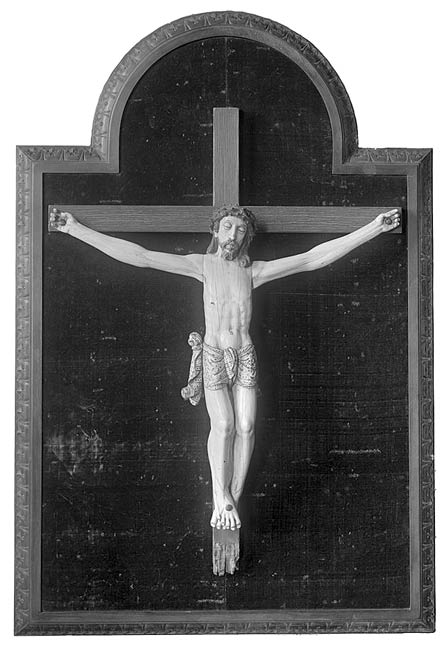We are constantly being told that we now live in a globalized world, yet the circulation of objects and ideas among diverse places and peoples is anything but a recent phenomenon. A case in point is Crucified Christ, or 1943.1082, an ivory statue from the Harvard Art Museums collections, which is a veritable global traveler that will be on view in the museums’ new galleries when they open in the fall of 2014. Its life history exemplifies the intensity of cross-cultural interactions that were occasioned by European nations’ advancing colonial expansion into Africa, the Americas, and Asia in the 16th and 17th centuries.
Little was known about the crucifix, which was part of an exceptional posthumous gift to the Fogg Museum in 1943 by Grenville Lindall Winthrop (1864–1943). Likely purchased by Winthrop from a dealer in Spain, it is identified in the museums’ object record only as “Spanish, early 16th century.” Writing to a friend in 1939, Winthrop expounded on the ideology behind his collecting practice: “We believe that objects sought for the collection must possess music, poetry, rhythm—that is to say Beauty” (Forbes and Sachs 1943). Winthrop must have considered the crucifix, with its elegant, elongated form and creamy sheen, particularly beautiful, regardless of its incomplete provenance and anonymous authorship. Indeed, a photograph from his house at 15 East 81st Street in Manhattan shows the object dramatically illuminated as the centerpiece of a chapel-like arrangement in one of the home’s stairwells.
In 2011, 68 years after Winthrop’s gift, I asked permission to see the ivory figure, among other medieval and early modern Spanish artworks, in early preparation for my general exams in the Department of the History of Art and Architecture. Joined at the museums by Tom Cummins, Professor of History of Art and Architecture, and a group of other graduate students, we hovered around the object. We peered at its fine carving, tracing where the red polychromy, which has largely disappeared, had been applied, and we debated the veining effect produced by the centuries of grime that had gathered in the minute cracks in the ivory. More than anything, however, we questioned its attribution as Spanish, listening to our gut feeling that it was, in fact, something quite different.
When an object has no available provenance information, as is the case with the Harvard Art Museums’ crucifix, careful visual comparison with better-researched objects can yield useful, if conjectural, leads concerning its origins. The style of the carving, especially in the sculptor’s rendering of the figure’s features, facial hair, and loincloth, is remarkably similar to large ivories depicting the crucified Christ that were produced in the Spanish-controlled Philippines during the 16th and 17th centuries. For example, based on similar objects from a museum in Valladolid, Spain, we know that the strongly demarcated veins on the figure’s arms, carved in relief and crisscrossing in a figure-eight pattern, are typical of a style of carving that we see primarily in Hispano-Philippine ivories from the first half of the 17th century (Casado Paramio 1997). There is no way to have absolute certainty as to the object’s origins, but a comparison of its formal characteristics to typologies developed by scholars who have analyzed similar crucifixes (Roda Peña 2005; Estella Marcos 2010) makes a strong case that this work of art was made in the colonial Spanish Philippines.
Colonial Hispano-Philippine ivories are the product of an impressively wide range of cultural influences, beginning with the African or Thai ivory that was shipped to the Philippines, probably by Portuguese merchants. Once there, the raw tusks were prepared and carved by Chinese artists, who had immigrated to the Philippines from mainland China. Using Netherlandish prints and figurines brought by missionaries as models, these sculptors skillfully navigated European iconographic conventions to satisfy their Spanish Catholic patrons, while retaining the aesthetic sensibilities and carving styles they had learned in local workshops. Although such religious ivories were sometimes used in churches in the Philippines for the conversion of local populations to Catholicism, they were primarily destined for export, given the American and European demand for luxurious Asian goods and art. It is possible that this crucifix was first sent to colonial Mexico, arriving in the port city of Acapulco on the famous Manila Galleon (known as the Nao de China) that traversed the Pacific Ocean once or twice a year. In Mexico, it was probably purchased by a wealthy individual for display at home or in a church, and then sent to Spain at an unspecified later date (Macías and Sánchez 2010). Traveling between Africa and Asia, where it was transformed from raw material to meticulously carved showpiece, and onward from Asia to the Americas, then Europe, and back to the Americas, and finally settling in Cambridge, the Harvard Art Museums’ ivory crucifix is undoubtedly one of the museums’ most itinerant objects, and, to me, one of the most compelling.
Adam Jasienski is a graduate student in the Department of History of Art and Architecture at Harvard University, where he also completed his undergraduate studies.
Casado Paramio, José Manuel. Museo Oriental de Valladolid, Catálogo II: Marfiles Hispano-Filipinos. Valladolid, Caja España, 1997. Estella Marcos, Margarita M. Ivories: From the Far Eastern Provinces of Spain and Portugal. Monterrey, Mexico: Cydsa, 2010. Forbes, Edward W., and Paul J. Sachs. “Grenville Lindall Winthrop.” Bulletin of the Fogg Art Museum, vol. 10, no. 2 (November 1943): 26–28. Macías, Rafael, and José María Sánchez. “El patronazgo artístico de Manuel Silvestre Pérez de Camino en la Rioja.” Atrio: Revista de Historia de Arte 15–16 (2010): 85–108. Roda Peña, José. “Un crucificado Hispano-Filipino de marfil en el Hospital del Pozo Santo de Sevilla.” Laboratorio de Arte 18 (2005): 319–326.



